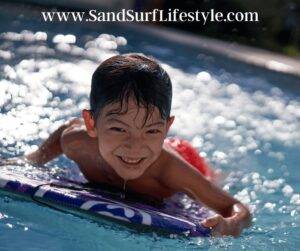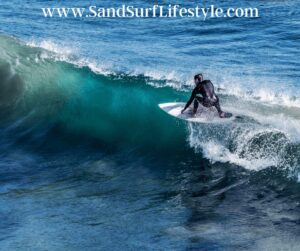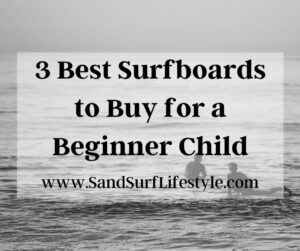3 Best Surfboards to Buy for a Beginner Child
Your child loves the water and waves. Every time you go to the beach, you get the pleading eyes and the questions of when, when can I learn to surf? As a parent, you might be looking at the waves and thinking, that’s a great question.
The three broad categories of beginner children’s surfboards are bodyboards, longboards in tandem, and softboards. Understanding and using information about surfboard categories will enhance your child’s success in learning to surf.
Parents want to encourage their children to try new experiences. Whether or not you are a surfer, providing support for your child will add to their confidence and accomplishments. Continue reading for information on surfboards for children and get them ready to ride a wave.
Elements of Surfboards
 Before heading to the surf shop, learning about the whys and how’s of surfboards and waves will help with surfboard selection. Surfboard shapes and materials are constructed to help the surfer with their buoyancy in the water.
Before heading to the surf shop, learning about the whys and how’s of surfboards and waves will help with surfboard selection. Surfboard shapes and materials are constructed to help the surfer with their buoyancy in the water.
Buoyancy:
Buoyancy is how well you and your board float. This is important because buoyancy gives the lift a board needs when getting up to speed and catching unbroken waves. High-volume boards paddle better because of their ability to float.
Volume:
Volume in a surfboard is computed in liters. It is a calculation of the length of the board, its width, and the surfboard’s thickness. This measurement is the total space of the surfboard. It will tell you the amount of water your board is displacing. Volume helps you catch the waves even when the waves are small and flat.
For beginning surfers, a focus on the volume of the board is important. Surfers must have floatation and buoyancy with their boards. Buoyancy helps the surfer paddle out to the waves. Once there flotation is necessary, so surfers can stand up or pop up on the board without sinking.
To increase volume on a board, length is required. This must be balanced with your child’s ability to handle the board. Surfers must be able to carry their board from the sand to the water. Once in the water, the board must be an appropriate length that the surfer can paddle and catch waves.
A reality of surfing is also falling or dropping a wave. So, surfers must be able to manage the board when they fall. Or when diving under a wave, the board needs to be a length the surfer can control.
Decisions on surfboard selection for a new surfer and a child should consider the total volume of the board and the ease with which your child can maneuver it.
Categories of Children’s Surfboards for Beginners
There are different age groupings frequently used to guide decisions on surfboards. However, determinations of which board is best should also include the attributes of each child. Before selecting a board, think about your child’s agility and physical ability. The goal is for a successful journey into the world of surfing.
Bodyboards:
 Bodyboards and boogie boards are the same thing. Boogie boards were created by Thomas Morey who named the board, Morey Boogie, after himself and his love of jazz. While bodyboards are not actually surfboards, they can be a great introduction to the water for a younger child.
Bodyboards and boogie boards are the same thing. Boogie boards were created by Thomas Morey who named the board, Morey Boogie, after himself and his love of jazz. While bodyboards are not actually surfboards, they can be a great introduction to the water for a younger child.
For most children under 7, splashing in the ocean is your best first step to surfing. Letting your child get comfortable with the waves and their power is important to develop a respect and love for the ocean. Playing in the sand, building sandcastles, and jumping the waves at the edge of the water is a wonderful initiation into the surf.
When your child is ready for a bit more of an adventure, introduce the bodyboard. These provide a terrific launch to dipping into the waves. For a young child, this is a fun way to getting rolling around in the waves. Children can learn to read the waves and discern the difference between those with power and ripples.
Using a bodyboard, children can learn to position their bodies on the board. Getting comfortable with the leash is another important skill. Taking it the next step and riding waves to the beach will develop confidence in your young surfer. Ducking into and bouncing back up from the waves as they crash into the beach will help your child immerse themselves in the waves.
Are Fish Surfboards Good for Beginners? Find out here.
Longboards in Tandem:
Longboards are the best boards to give you overall volume because of their length. The volume translates into buoyancy, which helps the board float. In addition to the length, a soft top on a longboard will add comfort for your child as they are learning. While a longboard would be too much for a young child to manipulate, it can be used to tandem surf with your child.
This option works for parents who are surfers. When riding in tandem, the adult or experienced surfer, paddles, carries the board, and positions the board on the waves. Depending upon the child’s size and strength, they can begin to assist in the paddling. This will introduce your child to larger waves and the steps it takes to surf.
Have your child focus on standing up on the board. With the longboard, the width will provide more area for your child to pop up on. With the larger surface area, practicing balance using a wider leg stance can also be done.
Soft or Foam Boards:
 With a longer board, surfers can more readily paddle and catch the waves because of the volume. However, it can be more difficult for a child to handle a longer board. It can be harder to position a longboard to catch a wave and to control the board when dodging under breaking waves.
With a longer board, surfers can more readily paddle and catch the waves because of the volume. However, it can be more difficult for a child to handle a longer board. It can be harder to position a longboard to catch a wave and to control the board when dodging under breaking waves.
Foam construction can be a great choice for any beginning surfer and particularly a child surfer. Softboards come in a variety of lengths. There are boards with a foam deck and a foam inner core. They have a solid bottom to allow you to ride the waves.
Many softboards are created with the beginner in mind. With the layers of foam, a surfer has a board with greater volume than longboards or shortboards. This volume makes paddling easier because of the board’s buoyancy. Effective paddling is essential to catch a wave. Surfers must paddle fast enough to reach the speed of the wave.
Additionally, the foam gives extra stability. Once you have caught the wave, softboards are easier to pop on. The cushioned top and added volume provide more stability. For those times when the waves create balance problems, softboards will not hurt as much when you fall.
Most foamies are durable. With their protective coatings, they do not ding easily. Foam boards are easier to transport, which can reduce your costs. They do not usually require a special bag to protect them. Many softboards are small enough for a child to carry. They provide good value for their costs especially if your child will not be surfing often.
Foam boards are great confidence builders, which is a key to success in surfing.
Other Considerations for New Surfers:
The board is all set, now there are just a few other steps. Two other extremely important thoughts to consider are swim and surf lessons. Regardless of learning to surf or not, it is truly vital for children to learn to swim. Before you begin shopping for the perfect surfboard, have your child take swim lessons.
If your child does know how to swim in a pool, remember the ocean is vastly different than a pool. Teaching your child about waves, currents, and riptides should be done regardless of surfing if you are a beach-going family. You want to empower your child with knowledge about the ocean, so they respect its energy.
Once your child is a proficient swimmer, they are ready to surf, fall off a board, or ditch a wave. Areas of strength in swimming that your child needs to do well are floating, kicking, treading water, and breathing underwater. Paddling is similar to the stroke of the front crawl. If you cannot paddle your board, you cannot catch a wave.
Depending upon your knowledge of surfing, another consideration is surf lessons. Before you invest in surf lessons, be sure your child has spent time at the beach and in the water. This is where using a bodyboard would be good to do before any lessons. You want your child to gain confidence when surfing; lessons with a knowledgeable instructor can accomplish that.
Related Questions:
Where should I buy a surfboard?
Surfboards are available for purchase almost anywhere. You can purchase a surfboard online, in surf shops, discount stores, yard sales, etc. Depending upon your knowledge of surfboards, you may want to shop at a surf shop that employs surfers.
Are used surfboards a good option for children?
Buying a used surfboard can be a great option for your child. This can minimize the investment you make in surfing until you know how often your child will surf. Many surf shops sell used boards.

Please note: This blog post is for educational purposes only and does not constitute legal or medical advice. Please consult a legal expert or medical professional to address your specific needs.

